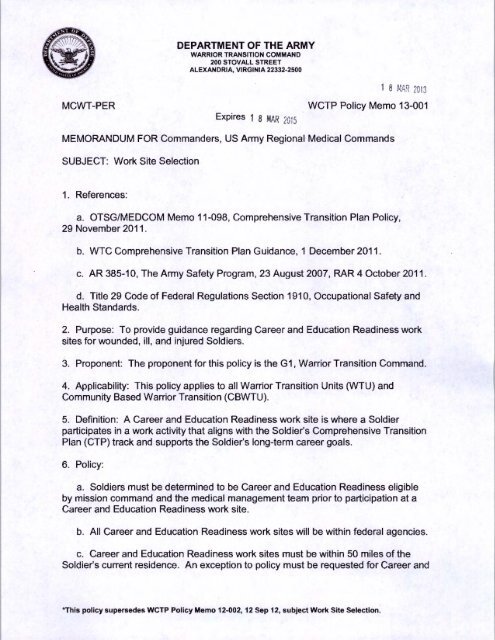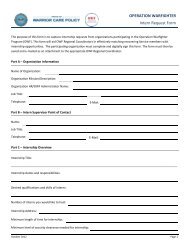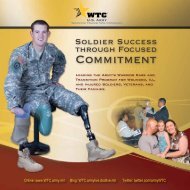WCTP Policy Memo 13-001 - Warrior Transition Command - U.S. Army
WCTP Policy Memo 13-001 - Warrior Transition Command - U.S. Army
WCTP Policy Memo 13-001 - Warrior Transition Command - U.S. Army
Create successful ePaper yourself
Turn your PDF publications into a flip-book with our unique Google optimized e-Paper software.
DEPARTMENT OF THE ARMYWARRIOR TRANSITION COMMAND200 STOVALL STREETALEXANDRIA, VIRGINIA 22332-2500MCWT-PERExpires 1 8 MAR 20151 8 1·t4R 20<strong>13</strong><strong>WCTP</strong> <strong>Policy</strong> <strong>Memo</strong> <strong>13</strong>-<strong>001</strong>MEMORANDUM FOR <strong>Command</strong>ers, US <strong>Army</strong> Regional Medical <strong>Command</strong>sSUBJECT: Work Site Selection1 . References:a. OTSG/MEDCOM <strong>Memo</strong> 11-098, Comprehensive <strong>Transition</strong> Plan <strong>Policy</strong>,29 November 2011.b. WTC Comprehensive <strong>Transition</strong> Plan Guidance, 1 December 2011.c. AR 385-10, The <strong>Army</strong> Safety Program, 23 August 2007, RAR 4 October 2011.d. Title 29 Code of Federal Regulations Section 1910, Occupational Safety andHealth Standards.2. Purpose: To provide guidance regarding Career and Education Readiness worksites for wounded, ill, and injured Soldiers.3. Proponent: The proponent for this policy is the G1, <strong>Warrior</strong> <strong>Transition</strong> <strong>Command</strong>.4. Applicability: This policy applies to all <strong>Warrior</strong> <strong>Transition</strong> Units (WTU) andCommunity Based <strong>Warrior</strong> <strong>Transition</strong> (CBWTU).5. Definition: A Career and Education Readiness work site is where a Soldierparticipates in a work activity that aligns with the Soldier's Comprehensive <strong>Transition</strong>Plan (CTP) track and supports the Soldier's long-term career goals.6. <strong>Policy</strong>:a. Soldiers must be determined to be Career and Education Readiness eligibleby mission command and the medical management team prior to participation at aCareer and Education Readiness work site.b. All Career and Education Readiness work sites will be within federal agencies.c. Career and Education Readiness work sites must be within 50 miles of theSoldier's current residence. An exception to policy must be requested for Career and*This policy supersedes <strong>WCTP</strong> <strong>Policy</strong> <strong>Memo</strong> 12-002, 12 Sep 12, subject Work Site Selection.
MCWT-PERSUBJECT: Work Site Selectioneducation Readiness work sites more than 50 miles from where the Soldier resides(Enclosure 1 ).d. Requests for an exception to policy must be initiated and signed by theWTU/CBWTU staff and signed by the WTU/CBWTU <strong>Command</strong>er; and:(1) Routed through the RMC WTO to the WTC, G-1.(2) The sole approval authority for an exception to policy is the <strong>Command</strong>er,<strong>Warrior</strong> <strong>Transition</strong> <strong>Command</strong>.e. All Career and Education Readiness work sites require a job hazard analysis.Composite Risk Management (CRM) will be used if specific hazards are identified.CRM is the process to mitigate hazards. A job safety analysis must be completed atleast once per work site unless there are physical changes to the work site that werenot previously identified as potential job hazards. An additional job safety analysiswill be required when potential job hazards are newly identified at a previouslycleared work site (Enclosure 2).f. Work sites outside the continental United States are not permitted except forSoldiers at WTU Fort Richardson, WTU Fort Wainwright, CBWTU-Puerto Rico,Pacific Regional Medical <strong>Command</strong> and Europe Regional Medical <strong>Command</strong>. Worksites at these locations will comply with paragraphs 6a through 6e of this policy.Overseas travel and travel across an international border are not permitted toaccommodate a selected Career and Education Readiness work site.7. Responsibilities: WTU/CBWTU <strong>Command</strong>ers are responsible for enforcing theprovisions of this policy.Enclasfl fJ2 ,~BISHOPBrigadier General, U.S. <strong>Army</strong>Assistant Surgeon Generalfor <strong>Warrior</strong> Care and <strong>Transition</strong>and <strong>Command</strong>ing General, WTC2
Encl 1 to Work Site SelectionClrdo: k _.,rlal.e C"'IY deslgt\alx>rcopy! COpy2 COQY lPERSONNEL ACTIONAUTHORJTY:PftiNCIPAL PURPOSE::·ROUTI£ USES:DATA REOI.MI:EO BY THE PRIVACY .M:f Of '<strong>13</strong>14Tate 5, 3 oel!
Encl 2 to Work Site SelectionJOB SAFETY ANALYSISINSTRUCTIONS ON REVERSE SIDEREQUIRED AND/OR RECOMMENDEDPERSONAL PROTECTIVE EQUIPMENT:WTC JOB SAFETY ANALYSIS FORMJOB TITLE: DATE: NEWPAGE OF JSA NO. REVISEDTITLE OF PERSON WHO DOES JOB: SUPERVISOR: ANALYS IS BY:WORK LOCATION: DEPARTMENT: REVIEWED BY:APPROVEDBY:SEQUENCE OF BASIC JOB STEPS POTENTIAL HAZARDS RECOMMENDED ACTION OR PROCEDURE--....._~( ~"'....... ·... '·/.....---~. "-..,',"·( ,/-~'\ ..,,,'',,, . ,...... ,' //\\\"'"' "'"''.,....'\\~"" ~(.~~ \\ """~ -"""~'\""'·~- "'"" ""-'>...--...,_( (,---\ 1\\... """'~-.-----.....~~""...''
Encl 2 to Work Site SelectionJob Safety Analysis (JSA) is an important accident prevention tool that works byfinding hazards and eliminating or minimizing. them before the job is performed,and before they have a chance to become accidents. Use JSA for job clarificationand hazard awareness, as a guide in new employee training, for periodic contactsand for retraining of senior employees, as a refresher on jobs which runinfrequently, as an accident investigation tool, and for informing employees ofspecific job hazards and protective measures.Set priorities for doing JSA's: jobs that have a history of many accidents, jobs thathave produced disabling injuries, jobs with high potential for disabling injury ordeath, and new jobs with no accident history.SEQUENCE OFBASIC JOB STEPSExamining a specific job by breaking it down into a series ofsteps or tasks, will enable you to discover potential hazardsemployees may encounter.Each job or operation will consist of a set of steps or tasks.For example, the job might be to move a box from aconveyor in the receiving area to a shelf in the storage area.To determine where a step begins or ends, look for a changeof activity, change in direction or movement.Picking up the box from the conveyor and placing it on ahandtruck is one step. The next step might be to push theloaded hand truck to the storage -area (a change in activity).Moving the boxes from the truck and placing them on theshelf is another step. The final step might be returning thehandtruck to the receiving area.Be sure to list a/It he steps needed to perform the job. Somesteps may not be performed each time; an example could bechecking the casters on the handtruck. However, if that stepis generally part of the job it should be listed.WTC JOB SAFETY ANALYSIS FORMSelect a job to be analyzed. Before filling out this form, consider the following:The purpose of the job - What has to be done? Who has to do it? The activitiesinvolved - How is it done? When is it done? Where is it done?In summary, to complete this form you should consider the purpose of the job, theactivities it involves, and the hazards it presents. If you are not familiar with aparticular job or operation, interview an employee who is. In addition, observing anemployee performing the job, or "walking through" the operation step by step maygive additional insight into potential hazards. You may also wish to videotape thejob and analyze it.Here's how to do each of the three parts of a Job Safety Analysis:POTENTIAL HAZARDS I RECOMMENDED ACTIONOR PROCEDUREA hazard is a potential danger. The purpose of the JobSafety Analysis is to identify ALL hazards- both thoseproduced by the environment or conditions and thoseconnected with the job procedure.To identify ha7..ards, ask yourself these questions about eachstep:Is there a danger of the employee striking against, beingstruck by. or otherwise making injurious contact with anobject?Can the employee be caught in, by. or between objects?Is there potential for slipping, tripping, or falling?Could the employee suffer strains from pushing, pulling,lifting, bending. or twisting?Is the environment hazardous to safety and/or health (toxicgas, vapor, mist. fumes. dust, heat, or radiation)?Close observation and knowledge of the job is important.Examine each step carefully to lind and- identify hazards -the actions, conditions. and possibilities that could lead to anaccident Compiling an accurate and complete list ofpotential hazards will allow you to develop therecommended safe job procedures needed to preventaccidents.Using the first two columns as a guide, decide what actionsor procedures are necessary to eliminate or minimize thehazards that could lead to an accident. injury. or occupationalillness.Begin by trying to: I) engineer the hazard out; 2) provideguards, safety devices, etc.; 3) provide personal protectiveequipment; 4) provide job instruction training; 5) maintaingood housekeeping: 6) insure good ergonomics (positioningthe person in relation to the machine or other elements insuch a way as to improve safety).List the recommended safe operating procedures. Beginwith an action word. Say exactly what needs to be done tocorrect the hazard, such as, "lift using your leg muscles."Avoid general statements such as, "be careful."List the required or recommended personal protectiveequipment necessary to perform each step of the job.Give a recommended action or procedure for each hazard.Serious hazards should be corrected immediately. The JSAshould then be changed to renect the new conditions.Finally. review your input on all three columns for accuracyand completeness. Determine if the recommended actions orprocedures have been put in place. Reevaluate the job safetyanalysis as necessary.








